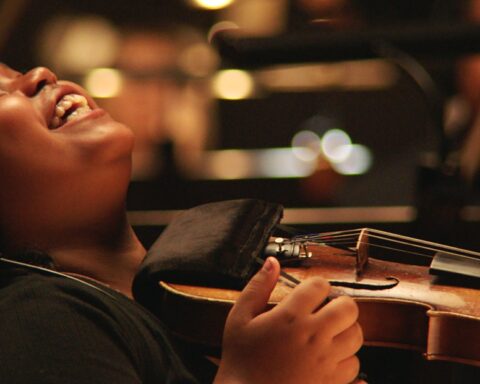The Music of Strangers: Yo-Yo Ma and the Silk Road Ensemble
USA, 2015
Dir. Morgan Neville
Programme: TIFF Docs (World Premiere)
Reviewed by Patrick Mullen
This year’s Toronto International Film Festival puts the emphasis back on “International” with the festival’s increased scope of world cinema reaching over seventy countries. The inaugural Platform sidebar adds a streak of international competitiveness, too, as does the range of stars competing for headlines. Nowhere else in the festival, however, might one find a better spirit of global interconnection than in the wonderful TIFF Docs selection The Music of Strangers: Yo-Yo Ma and the Silk Road Ensemble. The film marks another return to a musical subject for director Morgan Neville following his Oscar-winning 20Feet from Stardom and this cinematic opus is another impressive entry for the director, who is already having a great year with the Hot Docs hit Best of Enemies and the rock doc Under the Influence: Keith Richards also screening at the festival.
Music of Strangers offers a fine companion piece to 20 Feet from Stardom as Neville draws a series of voices together into one unified chorus. The film weaves a musical tapestry of cultures and accents as Neville chronicles the foundation of the Silk Road Ensemble by renowned cellist Yo-Yo Ma. The Silk Road Ensemble brings together a troupe of dedicated musicians from different corners of the globe, who all play instruments that reflect the cultural identities of their respective countries. China’s Wu Man plays the pipa while Spain’s Cristina Pato brings the bagpipes and lots of vitality. Kayhan Kalhor represents Iran with the kamancheh and Kinan Azmeh reps Syria with the clarinet. The four are core members in addition to a larger troupe of talented and diverse musicians who bring their respective accents to the ensemble as it travels the globe. The ensemble is a collision of cultures and the sound couldn’t be better: The Music of Strangers is a symphony for the eyes and ears alike. As the wonderful music swells, the film offers a world tour of sights and sounds that can’t be beat.
Neville structures the film similarly to the narrative scale of Twenty Feet from Stardom by starting with his key subject, Yo-Yo Ma, and charting his rise, significance, and passion. Segments chronicling similar traits of each of the core members follow, but Neville finds valuable dramatic weight in all their narratives as Silk Road comes together as each member experiences significant turning points in his or her respective countries. Economic hardships rock Spain for Pato’s family while Kalhor speaks of the revolution in Iran and Wu Man relates her experience growing up as a fortunate student in post-Maoist China. Each musician harnesses and celebrates cultural identities, and Silk Road empowers the musicians by sharing their cultures with peers from around the world. The music reclaims an aspect of culture that finds resistance both at home and abroad, such as Kalhor’s story of cancelled concerts in Iran or of Azmeh’s ability to connect with students at Syrian refugee camps through music.
The film sandwiches these storylines in between grand musical numbers that show the Silk Road Ensemble in its full force. It’s one thing to hear the members speak of the revelatory cultural fusion that happens in their performances, but it’s an entirely more powerful experience to hear it. Sequences with Pato’s energetic bagpipes are especially enthralling. This music is both familiar and new as the ensemble shares different elements of diverse cultures, such as using traditional instruments from one country to play a song from another. The result is not a clash of cultures, but a wonderful harmony.
Neville shoots the musical scenes impeccably. The performances in The Music of Strangers are just as impressive as the showstopping numbers of Twenty Feet from Stardom are, thanks to the bright and involving cinematography by Graham Wiloughby (Neville’s Stardom DP) that fluidly weaves around the musicians as they play in cities throughout the world. The performances are expertly staged, yet have the thrill of spontaneity. Each number plays like a wild fusion of classical music and jazz as the camera, musicians, and passersby jam and groove to the music. The soundtrack alone is worth the admission.
The Music of Strangers juxtaposes the harmony of the band with the personal storylines as they converge to Silk Road’s peak in a post 9/11 world characterized by rampant xenophobia and fraught conversations on nationalism. The music, however, underscores the foundational philosophy of the ensemble that teaches audiences to appreciate how each culture blends in a sonorous accord. Despite their perceived differences, the flavours of one culture complement those of another when everyone plays the same tune. The film is an inspiring account of the arts ability to break barriers and change the world as Neville follows the Silk Road Ensemble across borders and through genres to find a common voice sung and heard around the globe. This symphonic film mixes world cinema and world music to create its own beautiful harmony. It’s a note-perfect celebration of diversity.
Bonus! Watch a video of Yo-Yo Ma’s cello performance at the TIFF world premiere:











